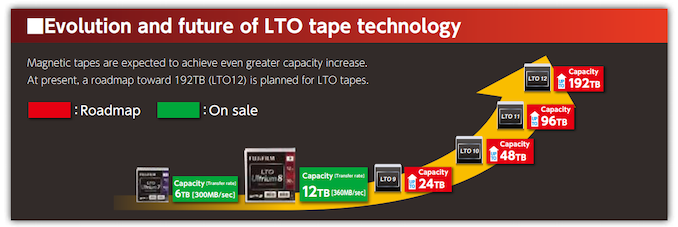400 TB Storage Drives In Our Future: Fujifilm
by Dr. Ian Cutress on June 30, 2020 8:00 AM EST
One of the two leading manufacturers of tape cartridge storage, FujiFilm, claims that they have a technology roadmap through to 2030 which builds on the current magnetic tape paradigm to enable 400 TB per tape.
As reported by Chris Mellor of Blocks and Files, Fujifilm points to using Strontium Ferrite grains in order to enable an areal data density on tape of 224 Gbit-per-square-inch, which would enable 400 TB drives. IBM and Sony have already demonstrated 201 Gbit-per-square-inch technology in 2017, with a potential release of the technology for high volume production in 2026. Current drives are over an order of magnitude smaller, at 8 Gbit-per-square-inch, however the delay between research and mass production is quite significant.
Strontium Ferrite would replace Barium Ferrite in current LTO cartridges. Strontium sits on a row above Barium in the periodic table, indicating a much smaller atom. This enables for much smaller particles to be placed into tracks, and thankfully according to Fujifilm, Strontium Ferrite exhibits properties along the same lines as Barium Ferrite, but moreso, enabling higher performance while simultaneously increasing particle density.
In standard LTO nomenclature, we are currently on LTO-8 where the drives have 12 TB raw capacity. Recent generational increases in LTO tend to double the capacity, so we’re looking at LTO-13 for 384 TB drives. Mellor indicates that there seems to be an average 2.5 years between commercialization of successive LTO drive standards, which leads to the following table:
| LTO Generation Progression | |||||||
| AnandTech | Standard | Retail | Length | Raw Cap. |
Speed MB/s |
Time to fill |
Material |
| LTO-1 | 2000 | 609 m | 0.1 TB | 20 | 1h23 | MP | |
| LTO-2 | 2003 | 609 m | 0.2 TB | 40 | 1h23 | MP | |
| LTO-3 | 2005 | 680 m | 0.4 TB | 80 | 1h23 | MP | |
| LTO-4 | 2007 | 820 m | 0.8 TB | 120 | 1h51 | MP | |
| LTO-5 | 2010 | 846 m | 1.6 TB | 140 | 3h10 | MP | |
| LTO-6 | 2012 | 846 m | 2.5 TB | 160 | 4h20 | MP/BaFe | |
| LTO-7 | 2010 | 2015 | 960 m | 6.0 TB | 300 | 5h33 | BaFe |
| LTO-8 | 2010 | 2017 | 960 m | 12.0 TB | 360 | 9h16 | BaFe |
| LTO-9 | 2014 | 2020 | 24.0 TB | *708 | *9h25 | BaFe | |
| LTO-10 | 2014 | *2022 | 48 TB | *1100 | *12h07 | Ba/Sr Fe | |
| LTO-11 | 2017 | *2025 | 96 TB | *1800 | *14h49 | SrFe | |
| LTO-12 | 2017 | *2027 | 192 TB | *2400 | *22h13 | SrFe | |
| LTO-13 | *2021 | *2030 | *384 TB | SrFe? | |||
| LTO-14 | *2021 | *768 TB | |||||
| *Unconfirmed/estimated | |||||||
Current generation LTO-8 cartridges take at least 9h16 to fill, with predicted speeds on future drives increasing that even further. Current LTO specifications go up to LTO-12, and so 400 TB would thus come in the LTO-13 generation.
Fujifilm states that 400 TB is the limit of Strontium Ferrite, indicating that new materials would be needed to go beyond. That said, we are talking about only 224 Gbit-per-square-inch for storage, which compared to mechanical hard disks going beyhind 1000 Gbit-per-square-inch today, there would appear to be plenty of room at the top if the technologies could converge.
Prices for current LTO-8 tape are the lowest out of all storage media. Depending on volume, prices around 0.8-1 cent per gigabyte is fairly common. Currently only Sony and Fujifilm are licencees to create LTO-8 media, however other companies such as HPE and IBM resell models under their own brand.
Source: Blocks and Files












32 Comments
View All Comments
falguni 222 - Thursday, July 9, 2020 - link
Tell GameStop Survey is an official customer experience feedback portal introduced by the GameStop Electronics retail company that supports its customers and visitors to share visiting experience and customer satisfaction at the outlet.https://surveytaker.info/www-tellgamestop-com-surv...
nandnandnand - Tuesday, June 30, 2020 - link
https://en.wikipedia.org/wiki/Holographic_data_sto...https://en.wikipedia.org/wiki/5D_optical_data_stor...
https://www.5dmemorycrystal.com/technology/
I am using "optical" in the broadest sense possible, since we don't know what specific technology would win out for portable data storage. But it is clear that there are "optical" options in the >100 TB range.
Simen1-Norge - Tuesday, June 30, 2020 - link
I believe quad layer BD-RE XL already are pushing the boundaries of optical media. Those are 10 USD/0.1TB. LTO are 25 USD/2.5TB. An order of magnitude difference.Guspaz - Tuesday, June 30, 2020 - link
BD-RE XL is triple layer, it's BD-R XL that is quad-layer. A double-sided BD-RE XL gets you 200GB per disc, but it's already been pushed further. Archival Disc uses the same laser and structure as BD-RE XL (triple layer per side) and holds 500GB per disc with the current generation and 1TB per disc with the next generation. They're still deciding where to go after that, as I believe that they see 1TB per disc as the limit without bigger changes.Kamen Rider Blade - Wednesday, July 1, 2020 - link
They can go "Quad Layer" like they did with Blu-Ray, but use "Archival Disc" density.But they can also have a extra data layer near the center of the disc structure like HD-DVD did, but using the "Archival Disc" laser density or Blu-Ray laser.
Whichever, it should be within the realm of possibility of 4 layers in the center and 4 layers near the surface, then mirror that sucker onto both sides for 16 layers in total.
LiKenun - Thursday, July 2, 2020 - link
I had read a decade ago that either Sony or Panasonic discovered a way to get about a dozen layers on a disc. I’m guessing that didn’t turn out to scale very well and so 4 layers was the best that they were able to manage for an economical product.Kamen Rider Blade - Sunday, July 5, 2020 - link
I think it has to do with signal to noise ratio, I've been delving into the technical side as to why they have some limit, when it comes to reading that many layers. The problem isn't fitting in more layers, the issue is reading the data back and getting noise from all the intermediate layers which makes it harder and harder to read back data accurately. That's probably why there are huge irregular gaps in between the Blu-Ray layers. If you read the White Paper / Technical Spec, the Blu-Ray layers all have different thickness gaps specified to help with Signal to Noise Ratio. The same could probably be true of stacking 10/20+ layers.shabby - Tuesday, June 30, 2020 - link
Maybe change the topic to "storage tapes" so people don't click on it thinking they'll see hard drives that big anytime soon.MenhirMike - Tuesday, June 30, 2020 - link
I love how LTO keeps evolving - also, because that means that older generations become affordable for home/prosumer use. LTO-4 and LTO-5 drives are pretty cheap (Note: LTO-5 native capacity is 1.5 TB, not 1.6 TB).ThereSheGoes - Tuesday, June 30, 2020 - link
Clickbait title.